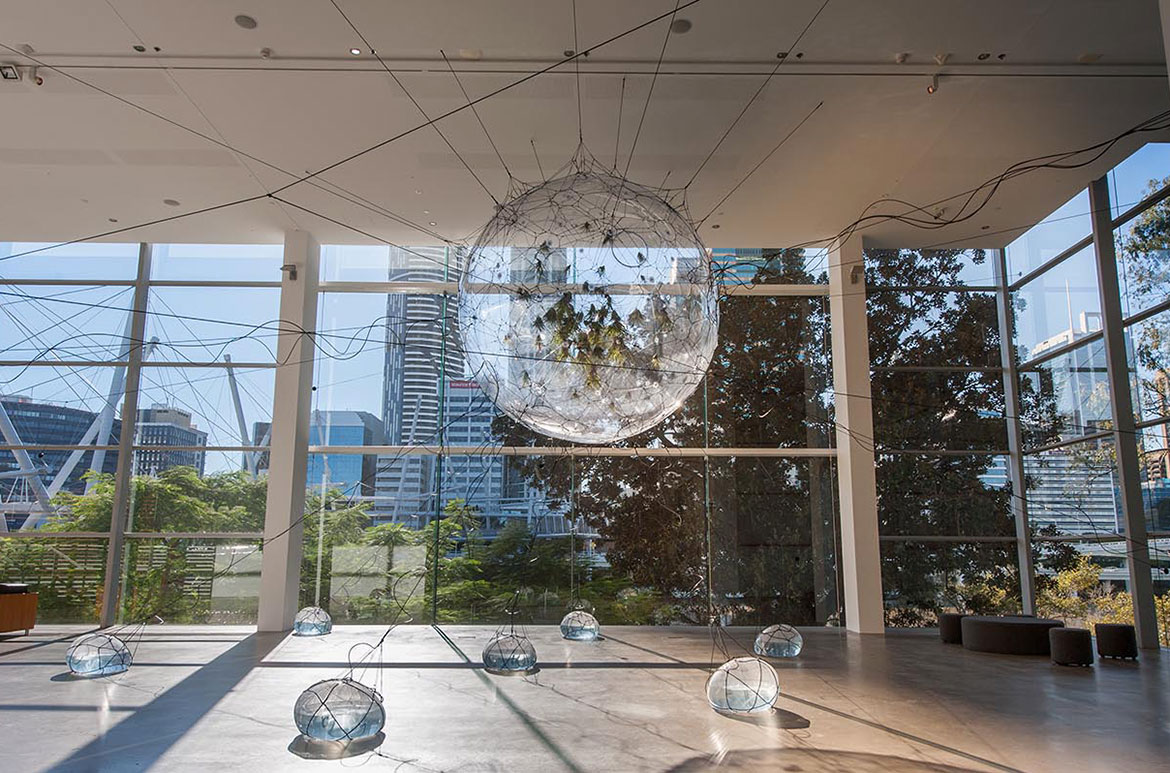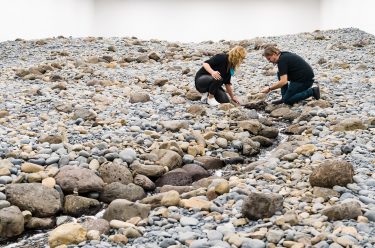Have you ever been to an exhibition at QAGOMA and walked away wanting to know more — for example — how did Qiu Zhijie create his enormous five-storey wall painting Map of Technological Ethics for ‘APT9’; alternatively, what did Ben Quilty use to create a series of site-specific, hand-drawn portraits of Margaret Olley — (teapots, jugs, and vases cast in chalk wouldn’t immediately come to mind) — what about — how did we create Olafur Eliasson’s commanding and interactive Riverbed, transforming an empty gallery in to an awe-inspiring rocky landscape; maybe you’d like to know how Céleste Boursier-Mougenot’s From here to ear (v. 13) 2010 which orchestrates a space for listening and experiencing was created as an environment for finches to feed, fly, rest and make music; or even how could we possibly get Cai Guo-Qiang’s 30m Eucalyptus tree into GOMA through the front doors?
Understandably, artists are protective of their work and sometimes don’t want to share too much in case it spoils the interpretation or gives away the installation process. Well, now you don’t have to be an art aficionado to know their secrets as we hopefully will be able to answer some of your unanswered questions. Watch a selection of time-lapse videos created over the years and go behind-the-scenes for a peak into the world of an art gallery.
We are fortunate to have been able to capture over 40 artworks and installations for you to see how major exhibitions are created. Watching the results of multiple frames speeding by in a time-lapse can be unbelievably satisfying, so head over to our YouTube playlist to watch them all and while away the time.
2019: Olafur Eliasson
During the ‘Water‘ exhibition which highlighted this precious resource, Olafur Eliasson’s commanding and interactive Riverbed 2014 offered audiences a chance to explore and ponder the existence of water. Is this the very first landscape on Earth, an environment yet to spring into life, or is this the last precious water source in a barren, post-apocalyptic future? Behind the vision of the renowned Danish/Icelandic artist and architect’s work was a huge team at QAGOMA all equipped with unique skill sets to transform an empty gallery in to an awe-inspiring rocky landscape.
Olafur Eliasson, Denmark/Iceland b.1967 / Riverbed 2014 installed at the Gallery of Modern Art, Brisbane 2019 / Water, rock (volcanic stones [blue basalt, basalt, lava], other stones, gravel, sand), wood, steel, plastic sheeting, hose, pumps / Courtesy: The artist; neugerriemschneider, Berlin; Tanya Bonakdar Gallery, New York/Los Angeles
2018: Patricia Piccinini
Watch our time-lapse as we install Patricia Piccinini’s multisensory immersive installation The Field 2018 in her exhibition ‘Curious Affection’, especially conceived for GOMA’s expansive spaces. The creatures for which Piccinini is renowned, sit in a field of over 3000 transgenic flowers that gently sway in response to passing viewers, the movement made possible by a multi-layer flooring system designed and manufactured by GOMA to function under the weight of the visitor.
Patricia Piccinini, Australia b.1965 / The Field 2018 / 3000 objects: ABS and PPE plastic / Courtesy: The artist; Tolarno Galleries, Melbourne; Roslyn Oxley9 Gallery, Sydney; and Hosfelt Gallery, San Francisco / © Patricia Piccinini
2017: Marvel
Go behind the scenes to view over 500 unique objects and costumes worn by your favourite superhero when earth’s mighty heros, their allies and adversaries from the pages of Marvel Comics to their big-screen incarnations, come together in the largest Marvel exhibition ever presented, exclusively for GOMA. Watch how we prepared, dressed and installed the costumes for The Avengers, just one of the many rooms in ‘Marvel: Creating the Cinematic Universe’, not to mention, never-before-seen set pieces from Thor: Ragnarok 2017, including the majestic Asgardian throne room and Hulk’s bed.
Installation view of the ‘Alternate dimensions’ room, ‘Marvel: Creating the Cinematic Universe’, GOMA 2017 / © MARVEL
2016: Haegue Yang
For ‘APT8’ Haegue Yang created Sol LeWitt Upside Down — Open Modular Cubes (Small), Expanded 958 Times 2015, a site-specific work for the Queensland Art Gallery Watermall. The installation consists of 1012 white Venetian blinds, arranged into grids and suspended from the ceiling in an inverted and expanded rendition of the ‘open modular cube’ structures, signature works of American conceptual artist Sol LeWitt.
Haegue Yang, South Korea/Germany b.1971 / Sol LeWitt Upside Down – Open Modular Cubes (Small), Expanded 958 Times 2015 / Aluminium Venetian blinds, aluminium hanging structure, powder coating, steel wire / 560 x 1052.5 x 562.5 cm / Commissioned for APT8. Purchased 2015 with funds from Tim Fairfax, AC, through the Queensland Art Gallery | Gallery of Modern Art Foundation / Collection: Queensland Art Gallery | Gallery of Modern Art / © Haegue Yang
2015: Asim Waqif
Asim Waqif created a site-specific work for ‘APT8’ at GOMA entitled All we leave behind are the memories 2015 that expanded through the gallery spaces. His installation is constructed from the worn and aged timbers typical of vernacular south-east Queensland architecture. Embedded with lights and sound sensors to be triggered by the viewer, this seemingly precarious structure is designed to be entered and explored.
Installation view of Asim Waqif’s site-specific work All we leave behind are the memories 2015
2014: Tomas Saraceno
The exhibition ‘Harvest’ celebrated food in art and included a large scale installation by Tomas Saraceno, renowned for his ambitious sculptures and installations that take the form of webs and interconnected spheres or bubbles. This group of works takes inspiration from the ‘Biosphere 2’ experiments in Arizona in the early 1990s, which analysed the possibility of humans living within closed ecological environments. Saraceno’s Biosphere 02 sculptures contains Tillandsia plants — a type of bromeliad that is native to the Americas, they receive all of their nutrients from water and air so are perfect for a closed ecosystem, like a floating garden.
Tomás Saraceno, Argentina b.1973 / Biosphere 02 2009 / PVC, rope, nylon monofilament, acrylic, plants (Tillandsia), air pressure regulator system, hydration system / Purchased 2014 with funds from Tim Fairfax, AC, through the Queensland Art Gallery | Gallery of Modern Art Foundation / Collection: Queensland Art Gallery | Gallery of Modern Art / © Tomás Saraceno
2013: Cai Guo-Qiang
Cai Guo-Qiang’s Heritage 2013 is a ‘last paradise’, inspired by Queensland’s North Stradbroke Island. The work if improbable, is an image of the natural world in a moment of perfect harmony, while also gently evoking a mood of crisis. Watch as we install 99 replicas of animals that bow to drink from a vast blue waterhole surrounded by white sand installed for ‘Cai Guo-Qiang: Falling Back to Earth’ and most recently seen in the ‘Water’ exhibition.
Cai Guo-Qiang, China b.1957 / Heritage 2013 / 99 life-sized replicas of animals / Commissioned 2013 with funds from the Josephine Ulrick and Win Schubert Diversity Foundation through and with the assistance of the Queensland Art Gallery | Gallery of Modern Art Foundation / Collection: Queensland Art Gallery | Gallery of Modern Art / © Cai Guo-Qiang
2012: Huang Yong Ping
Huang Yong Ping’s massive installations rework architectural and animal forms into a complex tableaux, drawing in elements of the sites in which they are constructed. Huang’s snake skeleton references a central symbol in Chinese culture, as well as other cultures around the world, playing with different interpretations of the snake, as well as referencing local landscapes and architecture. During ‘APT7’, Ressort 2012 dominated the Queensland Art Gallery’s Watermall, spiralling from the ceiling to the floor, metaphorically linking sky and water.
Huang Yong Ping, China/France 1954-2019 / Ressort 2012 / Aluminium, stainless steel / Purchased 2012 with funds from Tim Fairfax, AM, through the Queensland Art Gallery Foundation / Collection: Queensland Art Gallery | Gallery of Modern Art / © Huang Yong Ping
Feature image detail: Tomás Saraceno Biosphere 02 2009
#QAGOMA


